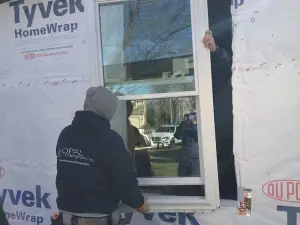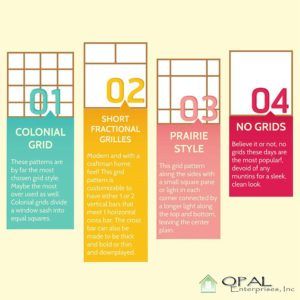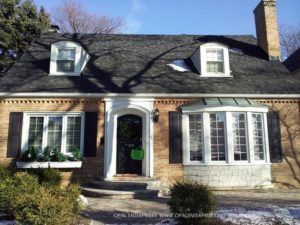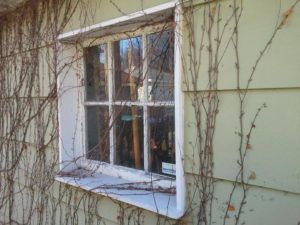
Opal workers installing new energy-efficient windows. If after measuring you find your windows are no longer energy efficient, call us to have new ones installed.
Every homeowner wants their windows to be energy efficient. Maybe you’re trying to reduce your heating bills during a cold Illinois winter or want to keep the heat out during our sweltering summers. Either way, your windows are a significant part of your home’s defense against the elements.
Yet, we’ve found that many people aren’t sure how to properly gauge if their windows are performing at peak levels. So, before replacing your old windows in Des Plaines and Naperville learn what to look for in new ones. Although the ratings may seem challenging to understand at first, they’re easy to figure out once you know what you’re looking for!
Always Choose Windows That Are Energy Star Rated
Energy Star is a rating by the federal government’s Environmental Protection Agency given to appliances, windows, and doors. The ratings promote energy efficiency.
Although participation in the program is entirely voluntary, many appliances and window manufacturers willingly create products that meet the EPA’s standards. After production, the manufacturers then have them tested by a qualified third-party evaluator.
Within the last several years, Energy Star ratings have become even more stringent. This means that Energy-Star-rated windows manufactured today are more than 30% more efficient than those manufactured in 2000.
Learn About the U-Factor for Your Windows
In colder climates, the U-factor is likely the most essential thing to consider. It’s sometimes called the U-value, and this number measures how well the window will prevent heat from escaping into the cold outdoors. Like in golf, the lower the U-factor, the better!
Think about your previous heating bills when choosing which windows to purchase. The higher your heating bills, the lower U-factor you should have. In Illinois, look for a U-factor of 0.40 or lower.
Learn About the Solar Heat Gain Coefficient for Your Windows
The solar heat gain coefficient (SHGC) is typically more important in warmer climates, and it measures how much solar heat comes into the home from the outside.
If you run your air conditioner nonstop in the summer months, look for an SHGC of 0.40 or lower, but if you only use your air conditioner occasionally, an SHGC of 0.55 is likely okay.
Combining U-Factor and SHGC to Find the Best Windows
If you’re unsure which number is more important for your home, Opal Enterprises can help you determine how to make the best choice to improve your home’s energy efficiency.
Now is actually an excellent time to replace your old and worn-out windows. Wait too long, and your heating bills could skyrocket during the long, cold winter months.
Although a typical window replacement can be done in just a day, it can make for a chilly day if you choose to do it in the middle of winter.
Visually Inspect Your Windows
Many interior and exterior window defects can be seen with the naked eye if you know what to look for. Choose an afternoon to walk around the exterior of your home, taking note of damaged glazing or disintegrating caulk.
If you discover worn-out caulk, you’ll see a gap between your home’s siding and your window frame. Outside air can penetrate this gap, causing uncomfortable conditions in your living area.
Spotting damaged glazing is also simple to identify. Glazing is the tough, putty-like material that holds individual windowpanes in place. If this substance becomes dry, cracked, and brittle, it likely isn’t fending off water, wind, or snow.
Use Smoke or Candles to Test Energy Efficiency
Using a candle or an incense stick is a straightforward way to check your window’s energy efficiency.
- First, turn off all your combustion appliances (i.e., furnace, water heater, oven).
- Next, close your doors and windows.
- Turn on any exhaust vents in your home to create a negative pressure environment. This will pull outside air into your house through openings and cracks.
- Then, light your incense sticks or candle near the edges of your windows (avoid flammable objects like your curtains).
- Finally, watch to see if any drafts blow the smoke or flame inward. This means your doors or windows are likely leaking air and need repair or replacement.
Use Technology to Check How Your Windows Are Performing
If you want to know precisely how well your windows are performing, or you think there might be a problem even after a visual inspection, there are other methods to measure energy efficiency.
Two of these include:
U-Value Kit
A U-value kit allows the exact measurement of the thermal insulation quality of your windows and other building materials. If you purchase a U-value kit to gauge window efficiency, follow the kit’s instructions and place the included sensor on the exterior and interior of your windows.
Then, attach the sensors to the kit’s data logging device, which you should connect to your computer to read the measurements.
To achieve the best results, perform the test on a day where the outside temperature is considerably cooler or warmer than the interior of your home.
Infrared (IR) Laser Thermometer
This device gives you highly accurate temperature readings of whatever is in front of you. It uses precise laser targeting to let you pinpoint hot or cool air leaks and helps you resolve problems faster.
To measure the energy efficiency of your windows, get a temperature reading from somewhere inside your home. Then, use the IR laser thermometer to check the temperature of your windows.
Next, compare the two numbers. If one of your windows is giving you a colder or warmer measurement than your baseline calculation, it’s likely leaking.
If Your Windows Are No Longer Energy Efficient, Act Today
At some point, everyone’s windows develop leaks or other issues. However, that doesn’t mean you should spend more on your energy bills and have to live with it. Instead, consider having new energy-efficient windows installed.
Window replacements not only help you save money on your power bills. They also make your home more comfortable and give it lasting value. If you need a window upgrade, contact the energy-efficiency experts at Opal Enterprises today.





